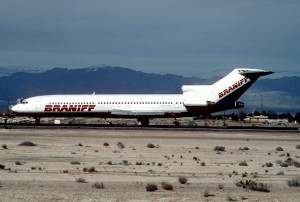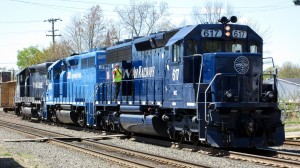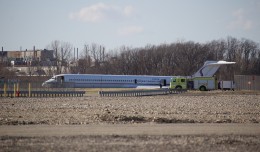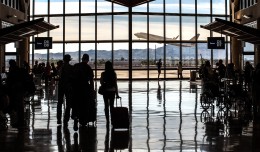The great airline industry shakeout that followed deregulation claimed various airlines, both new and established. Pioneering airlines such as Pan Am, Eastern and Braniff were unable to compete in the new free market environment. Some of the promising start-ups also ultimately succumbed to either soaring debts, fierce competition or both. In a few instances some of these failures were resurrected for a second (and in some cases third) go around. In this installment, we take a look back at four airlines that were started as comeback stories.
Braniff, Inc.
Most airline aficionados are familiar with the story of Braniff International Airlines. The airline expanded aggressively following deregulation, stretching itself too thin amidst a recession, the PATCO strike and fierce competition leading it to abruptly cease operations and file for bankruptcy in 1983. Later that year, the Hyatt Corporation, led by Jay Pritzker, bought the airline out of bankruptcy, taking control of 30 aircraft and restarting the airline as Braniff, Inc. The following year, the new Braniff, with a refreshed corporate identity, kicked off in grand fashion starting with a route network of 18 US cities from its hub at Dallas/Ft. Worth. Braniff featured an innovative cabin product, with a movable partition that allowed them to resize their “business class” cabin depending on passenger load. This idea was later abandoned and the airline switched to a low-fare business model featuring a single class of service.
Braniff found some initial success, posting back-to-back profitable years in 1985 and ’86. At this point the airline once again went into expansion mode, opening a second hub in Kansas City and adding a new fleet type in the 737. Braniff later acquired Florida Express Airlines , adding several BAC-111s to its fleet as well as new destinations and a third hub in Orlando which would later become the airline’s headquarters. By the late-’80’s, Braniff was starting to hemorrhage cash and ended up being purchased by BIA-COR Holdings. The new ownership placed an order for 50 Airbus A320s, with only a couple actually flying for the airline before it filed for bankruptcy in 1989 due to the high amount of debt incurred in purchasing the airline from Hyatt. Braniff was liquidated and started up again in 1991 by the BIA-COR group only to be shut down for good a year later amidst a host of legal issues. A truly sad ending for one of the great names in aviation.
Pan American Airways
Pan Am was one of the most iconic names in aviation, with a rich history dating back to the 1920’s. The airline was unable to compete in the deregulated environment, leading to its ultimate demise in 1991. The blue globe returned to the sky five years later, as an investment group bought the rights to the airline and restarted Pan Am in 1996 as a domestic airline based in Miami and serving the east coast and Caribbean. When the deregulation era started, the original Pan Am found that it needed additional domestic feed for its international flights, which lead to their merger with National Airlines. Ironically Pan Am II was started with hopes of becoming the domestic feeder by establishing codesharing agreements with international carriers at JFK and Miami. The following year the airline acquired Carnival Air Lines, owned and operated by the cruise line, which operated a similar route structure and like the new Pan Am had a fleet of A300 and 727 aircraft along with a few 737-400s. The two airlines never got a chance to fully merge as dwindling cash led to both companies filing for bankruptcy in 1998. Pan Am’s codesharing aspirations never materialized either.
New Hampshire-based Guilford Transportation Industries, a railroad company, purchased assets of the bankrupt Pan Am and launched a third incarnation of the airline later on in 1998. “Pan Am III” used a fleet of seven 727s to operate scheduled flights from the northeast to Florida and Puerto Rico, focusing on secondary airports like Worcester and Orlando-Sanford, as well as charter flights. Guilford ceased operating Pan Am flights in 2004, transferring operations to a subsidiary named Boston-Maine Airways which flew as Pan Am Clipper Connection until 2008. Meanwhile parent company Guilford changed its name to Pan Am Systems, in the process rebranding their rail operations as Pan Am Railways. After all these years the only place to see the iconic globe logo was on the side of a freight train.
Midway Airlines
The original Midway was featured in our previous installment, ending operations in 1993. The second incarnation actually started as Jet Express, a small carrier that operated as a feeder for TWA and USAir in the late ’80’s and early ’90’s. Jet Express acquired the Midway name from bankruptcy and in 1993 launched service from Chicago-Midway Airport to New York LaGuardia, Denver and Dalls using leased Fokker 100s. The Chicago operation lasted less than a year, with 90% of the airline being purchased by an investment firm which eventually moved Midway’s base of operation to Raleigh-Durham (RDU). Ironically the airline would never return to Midway Airport despite keeping the Midway name.
The new Midway thrived at RDU for a time in the late ’90’s, adding more Fokker 100s as well 737-700s and CRJs. At its peak, the airline served 25 cities, primarily on the east coast with destinations as far west as Los Angeles and as far south as San Juan, PR. The tech industry slump at the turn of the century, as well as Southwest’s entry into RDU spelled trouble for the airline, leading to a bankruptcy filing in August of 2001. The 9/11 attacks dealt a crushing blow to the airline, which stayed grounded until December of that year, at which time it returned as a shell of itself, flying five 737s to a handful of destinations. In 2002 Midway curiously switched gears, returning the 737s and leasing CRJs to become a US Airways regional subsidiary. The new flying was short lived as the airline filed for Chapter 7 bankruptcy in 2003 ceasing operations for good.
Frontier Airlines
Entering its 20th year of service, Frontier is by far the most successful of this group of airlines, and one of the longest-running start-ups of the deregulation era. Having said that, Frontier has had its ups and downs over the course of two decades having entered bankruptcy, been acquired two different times and presently reinventing itself as an Ultra Low Cost Carrier (ULCC).
The original Frontier, which was based in Denver, operated from 1950 until 1986 when it was acquired by Texas Air and merged into Continental Airlines. Years later Continental would close its longtime hub at Denver upon the closing of Stapleton International Airport, leaving a sizable void in capacity in the Denver market. In response to this opportunity, a group led by former Frontier executives launched a new Frontier in 1994. Frontier was started as a low-fare carrier with a single class of service but with a slightly higher level of in-flight amenities than the typical bare bones service offered by low-fare carriers of that time. Frontier, which had positive brand recognition in the Denver market, found early success despite having a hub at the newly opened Denver International Airport, which had high operating costs, as well as going head to head with United which also has a hub at the airport. Frontier enjoyed a measure of success early on, operating flights to both coasts from the Denver hub. Expansion continued with a large order for Airbus A319 and A320 aircraft in 1999 which would ultimately replace the airline’s fleet of 737s. The new Airbus jets came equipped with seatback TVs that featured several DirecTV channels, further enhancing Frontier’s onboard product offering.
Frontier entered a rough stretch in the years that followed. Southwest Airlines entered the Denver market and established a large presence, giving the airport a third major player. The added competition led Frontier to experience substantial financial losses, leading to a bankruptcy filing in 2008. At this time, the airline was acquired by Republic Airlines, a regional carrier that had begun its relationship with Frontier by operating regional jet services from the Denver hub. Republic had also acquired the struggling Midwest Airlines, combining the assets of both airlines in an effort to establish Republic as a mainline carrier. Republic initially operated both Frontier and Midwest as separate brands, swapping aircraft between the two as needed for their operation. Not surprisingly this led to confusion among the flying public as both airlines offered differing levels of amenities and airfare structure, and consequently both airlines continued to struggle. Republic decided to consolidate the two airlines under the Frontier brand, eventually leading to Frontier being spun off into its own independent carrier in the hopes that it could eventually be sold off. As part of this spin-off, Frontier began to change its business model to that of a ULCC, similar to that of Allegiant and Spirit. This included moving away from the hub-and-spoke route network the airline had used throughout its history, expanding its route map by opening up service from secondary airports – including a focus city in Trenton, NJ – and adding point-to-point service in cities that had lost service due to recent airline mergers. While Frontier already charged fees for extra amenities like DirecTV and extra legroom, the carrier further moved to an “unbundled” pricing strategy, charging for items such as soft drinks and later carry on baggage. The strategy proved effective as Frontier has returned to profitability. In late 2013 Frontier was acquired by Indigo Partners, the former parent company of Spirit. Since then Frontier has continued to establish itself as a ULCC, taking advantage of “outside the box” opportunities to continue growing, such as opening a focus city at Washington Dulles. Time will tell whether Frontier’s comeback will have staying power.
Gabe Andino is an Associate Editor for NYCAviation.com, aviation enthusiast and airport management professional residing in New Jersey. Follow him on Twitter @OGAndino












